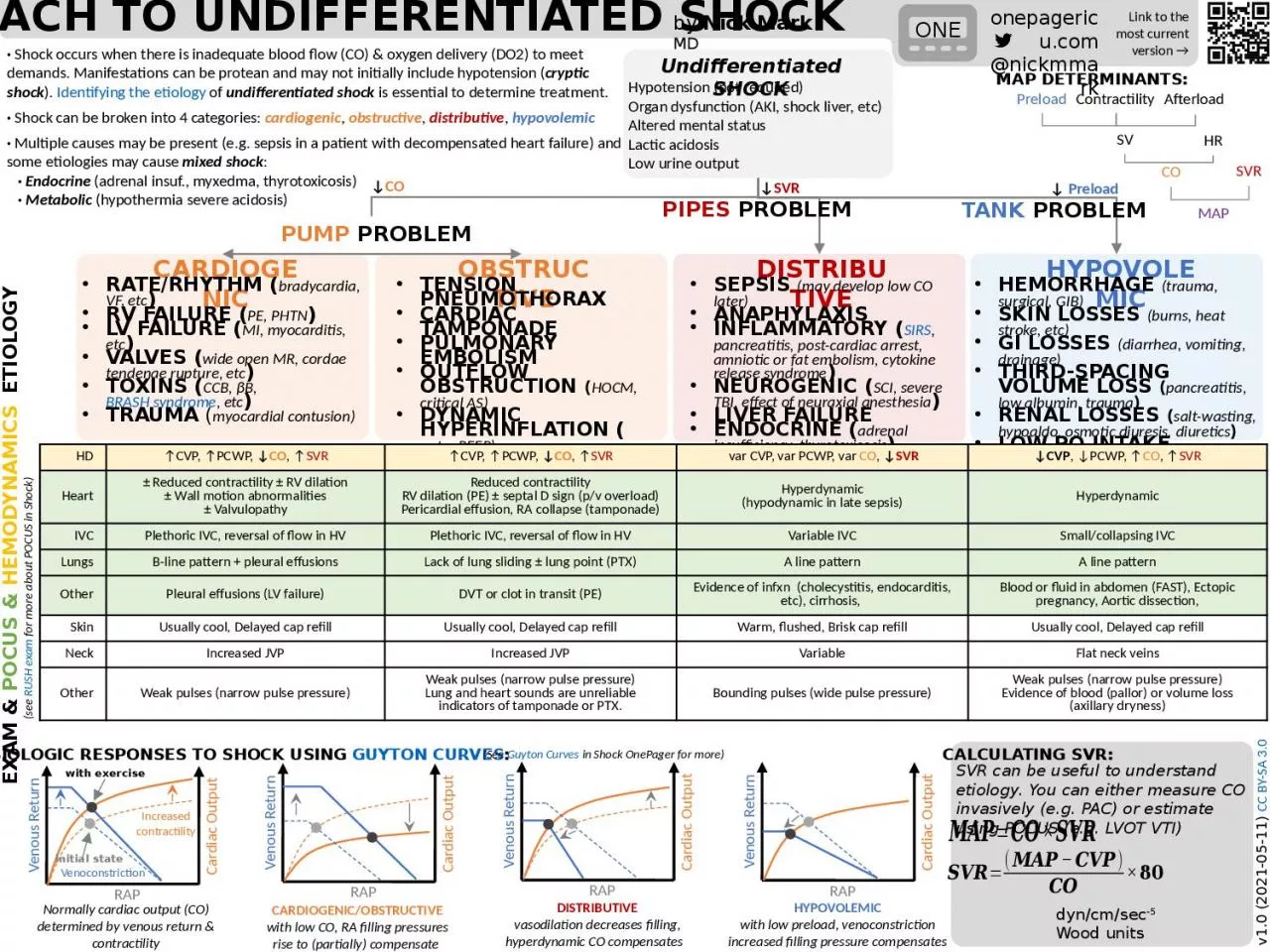

onepagericucom nickmmark Link to the most current version ONE Undifferentiated SHOCK CARDIOGENIC OBSTRUCTIVE DISTRIBUTIVE HYPOVOLEMIC PUMP problem PIPES problem TANK problem ID: 1011835
Download Presentation The PPT/PDF document "by Nick Mark MD approach to undiffere..." is the property of its rightful owner. Permission is granted to download and print the materials on this web site for personal, non-commercial use only, and to display it on your personal computer provided you do not modify the materials and that you retain all copyright notices contained in the materials. By downloading content from our website, you accept the terms of this agreement.
1. by Nick Mark MDapproach to undifferentiated shockonepagericu.com@nickmmarkLink to the most current version →ONEUndifferentiated SHOCKCARDIOGENICOBSTRUCTIVEDISTRIBUTIVEHYPOVOLEMICPUMP problemPIPES problemTANK problemrate/rhythm (bradycardia, VF, etc)rv failure (PE, PHTN)lv failure (MI, myocarditis, etc)valves (wide open MR, cordae tendenae rupture, etc)toxins (CCB, βB, BRASH syndrome, etc)trauma (myocardial contusion)tension pneumothoraxcardiac tamponadepulmonary embolismoutflow obstruction (HOCM, critical AS)dynamic hyperinflation (auto- PEEP)sepsis (may develop low CO later) anaphylaxisinflammatory (SIRS, pancreatitis, post-cardiac arrest, amniotic or fat embolism, cytokine release syndrome)neurogenic (SCI, severe TBI, effect of neuraxial anesthesia)liver failureendocrine (adrenal insufficiency, thyrotoxicosis)medications (anesthesia, sedation)hemorrhage (trauma, surgical, GIB)skin losses (burns, heat stroke, etc)gi losses (diarrhea, vomiting, drainage)third-spacing volume loss (pancreatitis, low albumin, trauma)renal losses (salt-wasting, hypoaldo, osmotic diuresis, diuretics)low po intakeEXAM & POCUS & Hemodynamicsv1.0 (2021-05-11) CC BY-SA 3.0ETIOLOGY· Shock occurs when there is inadequate blood flow (CO) & oxygen delivery (DO2) to meet demands. Manifestations can be protean and may not initially include hypotension (cryptic shock). Identifying the etiology of undifferentiated shock is essential to determine treatment.· Shock can be broken into 4 categories: cardiogenic, obstructive, distributive, hypovolemic· Multiple causes may be present (e.g. sepsis in a patient with decompensated heart failure) and some etiologies may cause mixed shock: · Endocrine (adrenal insuf., myxedma, thyrotoxicosis) · Metabolic (hypothermia severe acidosis)HD↑CVP, ↑PCWP, ↓CO, ↑SVR↑CVP, ↑PCWP, ↓CO, ↑SVR var CVP, var PCWP, var CO, ↓SVR↓CVP, ↓PCWP, ↑CO, ↑SVRHeart± Reduced contractility ± RV dilation± Wall motion abnormalities± ValvulopathyReduced contractilityRV dilation (PE) ± septal D sign (p/v overload)Pericardial effusion, RA collapse (tamponade)Hyperdynamic(hypodynamic in late sepsis)HyperdynamicIVCPlethoric IVC, reversal of flow in HVPlethoric IVC, reversal of flow in HVVariable IVCSmall/collapsing IVCLungsB-line pattern + pleural effusionsLack of lung sliding ± lung point (PTX)A line patternA line patternOtherPleural effusions (LV failure)DVT or clot in transit (PE)Evidence of infxn (cholecystitis, endocarditis, etc), cirrhosis, Blood or fluid in abdomen (FAST), Ectopic pregnancy, Aortic dissection,SkinUsually cool, Delayed cap refillUsually cool, Delayed cap refillWarm, flushed, Brisk cap refillUsually cool, Delayed cap refillNeckIncreased JVPIncreased JVPVariableFlat neck veinsOtherWeak pulses (narrow pulse pressure)Weak pulses (narrow pulse pressure)Lung and heart sounds are unreliable indicators of tamponade or PTX.Bounding pulses (wide pulse pressure)Weak pulses (narrow pulse pressure)Evidence of blood (pallor) or volume loss (axillary dryness) dyn/cm/sec-5 Wood units ↓CO↓ Preload↓SVR Hypotension (not required)Organ dysfunction (AKI, shock liver, etc)Altered mental statusLactic acidosisLow urine outputCALCULATING SVR:SVR can be useful to understand etiology. You can either measure CO invasively (e.g. PAC) or estimate using POCUS (e.g. LVOT VTI) RAPVenous ReturnCARDIOGENIC/OBSTRUCTIVEwith low CO, RA filling pressures rise to (partially) compensate Cardiac OutputRAPVenous ReturnHYPOVOLEMICwith low preload, venoconstriction increased filling pressure compensatesCardiac OutputPHYSIOLOGIC RESPONSES TO SHOCK USING GUYTON CURVES:RAPVenous ReturnDISTRIBUTIVEvasodilation decreases filling, hyperdynamic CO compensates Cardiac OutputPreloadContractilitySVHRCOSVRMAPAfterloadMAP DETERMINANTS:RAPVenous ReturnCardiac OutputNormally cardiac output (CO) determined by venous return & contractility(See Guyton Curves in Shock OnePager for more)(see RUSH exam for more about POCUS in Shock)Increased contractilityVenoconstrictionwith exerciseinitial state